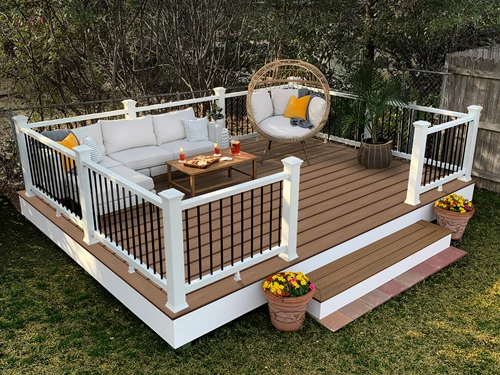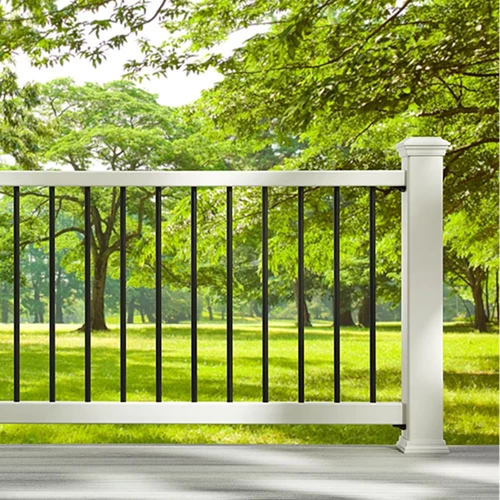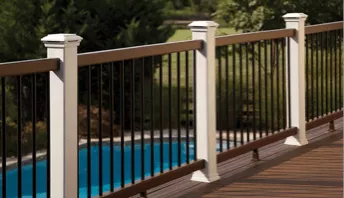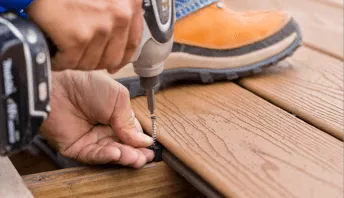Innovative Deck Railing Ideas that Won’t Break the Bank

Transforming your outdoor space with style and safety doesn't have to be expensive. Affordable deck railing ideas are popular among DIY enthusiasts and budget-conscious homeowners. Whether adding a new area or updating an existing one, choosing the right railing materials and designs can enhance your deck's look without breaking the bank.
In this post, we’ll cover practical and cost-effective deck railing solutions. From materials to DIY tips and maintenance, we've got all you need to make the right choice for your home.
Explore a variety of budget-friendly materials like pressure-treated wood, aluminum, steel, vinyl, or composite. Wood stands out as one of the most affordable choices, while aluminum and steel railings bring durability with a sleek, modern vibe. Vinyl and composite railings offer a timeless, low-maintenance option that’s built to withstand the elements. The goal is to strike a balance between cost and style to match your personal taste.

Why Choose Budget-Friendly Deck Railing Solutions?
Deck railings serve not only as protective barriers but also as design elements that enhance your outdoor space. However, high costs can be a barrier for many homeowners. Here are a few things to consider when selecting the deck railing for your project:
- Affordability: The ideal railing option is one that fits within your budget. It's essential to choose railings that not only meet your price range but also provide the necessary safety.
- Customization: Many railings offer customization options to enhance both their appearance and functionality. Consider the different materials, colors, and features such as lighting and ADA handrails to create a design that fits your specific needs and style.
- DIY-Friendly: Many budget-friendly railing options are easy to install yourself which can help you save on labor costs if you are up to the challenge.
- Longevity: Opt for a railing product with a strong warranty. Brands like Trex provide competitive warranties, ensuring a long-lasting solution so you can build with confidence and avoid the need for future replacements.
Deck Railing Components Explained

Deck railings are made up of several key components that contribute to their strength, safety, and overall appearance. Here’s a closer look at the essential parts of a deck railing system:
- Top Rail : The top rail runs horizontally between the posts at the top of your railing section. It provides the main support for the infill below and offers a comfortable surface to lean on or grasp, contributing to the overall stability of the railing.
- Bottom Rail : The bottom rail runs parallel to the top rail and connects between the posts at the base of the infill. It plays a key role in securing the infill in place and ensures the stability and alignment of the railing system.
- Infill : The infill fits between the top and bottom rails, filling the space within the railing. Depending on your style and preference, infill can be made from various materials, such as balusters, glass panels, or cables, adding both safety and visual appeal to your porch railing ideas.
- Post : Posts are the vertical elements that anchor the railing system to the deck or porch surface. They provide essential structural support for both the top and bottom rails, as well as the infill.
- Post Cap : The post cap is a decorative piece that sits atop each post. It adds an aesthetic touch to the railing system and often includes protective features, with options that can also incorporate lighting for added ambiance.
- Post Skirt : The post skirt is a trim piece at the base of each post where it meets the deck or porch surface. It covers any gaps or hardware, providing a finished look while protecting the connection point from moisture and debris.
- Foot Block: The foot block goes underneath the bottom rail to provide additional support and stability. Without foot blocks, the deck railing is more susceptible to sagging over time, compromising its appearance and structural integrity.
For a more detailed look, check out our article on Parts of a Deck Railing .

Most Affordable Deck Railing Materials
When considering deck railing ideas, materials like wood, composite, aluminum, steel, and vinyl offer a compelling mix of affordability and durability. Although their initial costs might be higher than some alternatives, their resilience and low maintenance needs ensure they remain cost-effective choices over time.
Selecting the right material is key to balancing cost and quality. Here are some affordable materials to consider for your next railing project:
- Wood: A classic choice, wood offers a warm and natural look that's easy to customize. Although it requires maintenance, such as staining or painting, its affordability makes it a popular option.
- Composite: Made from a mix of wood fibers and recycled plastics, composite railings offer durability without upkeep. They come in various colors and styles, making them versatile for any design. Composite railings last anywhere from 25-35 years on average.
- Aluminum: Aluminum railings provide a sleek, modern look at a reasonable price. They're durable, low-maintenance, and can be powder-coated for added protection and aesthetics.
- Steel: Steel railings provide exceptional strength and stability, making them a perfect choice for those in need of a sturdy outdoor barrier. However, carbon steel is susceptible to rusting in regions with high moisture levels.
- Vinyl: Vinyl railings are an appealing choice for homeowners seeking a standard look for their railing.
These materials not only help keep costs down but also offer flexibility in design and installation.

Metal Deck Railing
Metal deck railings are a popular option for both modern and traditional designs, thanks to their durability and low maintenance. The most common types are aluminum and steel. Aluminum railings are particularly appealing due to their resistance to rust and corrosion, offering a long-lasting, cost-effective solution. While steel railings are often slightly more affordable, they lack the same rust and corrosion resistance and typically come with shorter warranty coverage.
When considering deck railing ideas, metal provides a wide range of styles, from sleek and minimalist to classic and ornate. Aluminum railings are often available in various neutral colors, with black being the most popular choice.
Pros of Metal Railings:
- Durability: Metal railings, particularly those made from steel or aluminum, are known for their strength and durability.
- Low Maintenance: Unlike wood, metal railings require minimal upkeep, with no need for regular staining or sealing, especially if coated with protective finishes like powder coating.
- Aesthetic Versatility: Metal railings offer a wide range of styles and finishes, from sleek modern designs to more ornate, traditional looks, allowing for customization to suit different architectural preferences.
- Cost-Effective Over Time: While the initial cost might be higher than some materials, the durability and low maintenance requirements often make metal railings a cost-effective option in the long run.
Cons of Metal Railings:
- Susceptibility to Rust: If not properly treated or maintained, certain metals like iron or steel can rust, particularly in humid or coastal environments, potentially compromising their appearance and integrity.
- Higher Initial Cost: Metal railings, especially custom designs or those made from premium metals, can be more expensive upfront compared to pressure-treated wood.
Steel Railing
Steel railings are a robust and versatile choice for enhancing any outdoor space. Known for their exceptional durability, steel railings can withstand severe winds, making them a long-lasting option for deck and porch applications. Unlike wood, steel does not succumb to issues like rot or insect damage, and its strength ensures reliable safety and stability.
Steel is also relatively low maintenance, requiring only occasional cleaning and the potential for rust protection treatments. Steel railings offer a sleek, modern aesthetic and can be customized with various finishes, including powder coating in a range of colors. These finishes not only enhance their appearance but also provide an extra layer of protection against corrosion.
Pros of Steel Railings:
- Durability: Steel railings offer a blend of strength and durability.
- Low Maintenance: They require lower maintenance than wood and periodic maintenance to delay rust.
- Aesthetic Options: Steel railings offer a sleek, modern look and can be customized with powder-coated finishes in various colors to enhance their visual appeal.
- Safety and Stability: Their robustness ensures reliable safety and stability, providing a secure barrier for decks and porches.
- Versatility: Steel railings can fit a wide range of design preferences, from minimalist to ornate, making them suitable for various architectural styles.
Cons of Steel Railings:
- Higher Initial Cost: The initial purchase price of steel railings can be higher compared to materials like wood, though they may offer savings over time due to their durability.
- Susceptibility to Rust: While resistant to many environmental factors, non-stainless steel railings can be prone to rust if not properly maintained, especially in coastal areas with high salt exposure.

Mixed Material Railing
For a unique and custom appearance, mixed material railings combine different elements such as wood, metal, or mesh panels. This approach allows for a creative approach to railing design.
Pros of Mixed Material Railings:
- Customization: Mixed material railings allow for a high degree of customization, enabling combinations like hog rail infills with vinyl or steel to create unique designs that suit various architectural styles and personal tastes.
- Durability: Utilizing materials like composite in combination with steel mesh infills can significantly enhance the durability of the railings, providing strength and resistance to weather conditions.
- Aesthetic Appeal: These railings offer a modern and stylish appearance, with options to blend natural textures with sleek metal or durable composite finishes, making them appealing in both contemporary and rustic settings.
- Low Maintenance: Vinyl, metal, and composite components typically require less maintenance than traditional wood, reducing the need for frequent painting or sealing and making them cost-effective over time.
- Versatility: The mix of materials can adapt to various environments, providing options for both indoor and outdoor use while accommodating a range of structural and design requirements.
Cons of Mixed Material Railings:
- Complex Installation: The integration of different materials can complicate the installation process, potentially requiring specialized tools or professional assistance.
- Inconsistent Aging: Different materials age at different rates, which can lead to uneven wear and potential aesthetic mismatches over time.
- Potential Compatibility Issues: Ensuring compatibility among materials to avoid issues such as corrosion when using steel alongside other materials requires careful planning and material selection.

Composite Deck Railing
Composite railings have become increasingly popular due to their balance of cost, durability, and low-maintenance requirements. Made from a blend of wood fibers and recycled plastics, composite deck railings like Trex Select T-rail are more environmentally friendly and resistant to rot, termites, and moisture damage compared to traditional wood railings. Their ease of installation and longevity make them an appealing option for homeowners seeking to upgrade their outdoor spaces. Although the initial cost may be higher, the reduced upkeep and extended lifespan often result in lower overall costs.
Trex offers a versatile range of composite deck railing options with various styles, colors, and textures to suit any design preference. These railings can be customized with accessories like lighting and gates, offering both aesthetic flexibility and practical benefits. Combining durability with minimal maintenance, Trex railings make an exceptional choice for modern decking solutions, providing both beauty and resilience to enhance any outdoor space.
Pros of Composite Deck Railings:
- Durability: Composite railings are highly durable, and resistant to rot, termites, and moisture damage, ensuring longevity and reducing the need for frequent replacements.
- Low Maintenance: They require minimal upkeep, eliminating the need for regular sealing, staining, or painting, unlike wood railings.
- Environmental Benefits: Made from a blend of wood fibers and recycled plastics, composite railings are more environmentally friendly than traditional wood options.
- Aesthetic Variety: Composite railings come in a wide range of styles, colors, and textures, allowing for customization to match any outdoor design preference.
- Ease of Installation: These railings are often designed for easy installation, making them a practical choice for DIY projects or professional installations.
Cons of Composite Deck Railings:
- Higher Initial Cost: The upfront cost of composite railings can be higher than wood, although they often prove more cost-effective over time due to their durability and low maintenance.
- Bulkier Look: Compared to the thin balusters, rails, and posts available with metal railings, composite rails tend to be thicker in nature.

Wood Deck Railing
Wood deck railings are an affordable choice for those seeking a classic aesthetic. With the ability to customize using different stains and paints, wood offers versatility for homeowners, but remember the constant upkeep of choosing this material.
While the initial investment is lower than composite or metal railings, wood requires maintenance to ensure longevity. To protect against natural deterioration like rotting and warping, regular sealing, staining, and painting are essential.
Pros of Wood Deck Railings:
- Affordability: Wood deck railings are often the most cost-effective option during the installation phase, making them accessible for a variety of budgets. Just remember over the years they could end up costing you more in maintenance.
- Customization Options: Wood railings can be easily customized with various stains and paints to match existing decks, pillars, or home décor, providing versatility in color.
- DIY Friendly: Wood railings can be a rewarding DIY project for those interested in hands-on home improvement, allowing for creativity and personal touches.
Cons of Wood Deck Railings:
- Maintenance Requirements: Wood requires regular upkeep such as sealing, staining, and painting to protect against the elements and preserve its appearance.
- Susceptibility to Deterioration and Instability: Wood is prone to issues like rotting, warping, and insect damage, which can lead to additional maintenance and repair costs over time. There's also the risk of splintering
- Environmental Considerations: The need for continuous maintenance and the potential for deterioration raise concerns about the environmental impact and sustainability of using some species of wood.
- Longevity:Compared to composite or metal options, wood railings have a shorter lifespan, leading to more frequent replacements.

How to Choose the Right Deck Railing
When planning your budget for deck railings, consider these key factors:
- Initial Material Costs: The upfront expense varies by material type. Wood is often the most affordable initially, while composite and metal options may cost more but offer longer-term benefits.
- Installation Fees: Costs include labor if hiring professionals or equipment if DIYing. Professional installation ensures quality and code compliance but can be pricier, while DIY may save money but requires skill and effort.
- Maintenance Costs: Ongoing expenses vary by material. Wood requires more frequent upkeep compared to low-maintenance composite or metal railings.
- Railing Life Expectancy: The lifespan affects how often you'll need replacements. Composite and metal typically last longer than wood.
- Replacement Costs: Consider potential replacement costs to align with your budget and longevity goals.
- Style: Custom designs or high-end materials can increase costs. It is important to find a railing that fits both your style and budget.
- Region: Different regions may have different building codes and regulations that can affect the cost of railing materials and installation. Be sure to research these factors before making a decision. It's crucial to choose a product that can withstand salt spray and extreme weather conditions.
Evaluating these factors helps in making an informed decision that fits your aesthetic, budget, and long-term needs. For more details on how to choose the right deck railing, explore this article on How to Choose the Right Railing.

Things to Consider When Building DIY Deck Railings
When planning your deck railing project, especially if you're considering a DIY approach, keep these additional considerations in mind:
- Railings with Time-saving Features: Railing template, pre-assembled panels, railing kits and more can help ease the order and install process. If you are planning to install railing yourself, consider investing in railings that offer a simplified build and ordering process.
- Guardrails: Most local building codes require any deck higher than 30” off the ground to have a guardrail.
- Height Compliance: Ensure that guardrail height is at least 36 inches, as required by most building codes. This standard helps provide adequate safety and security for the railing, preventing accidental falls.
- Baluster Spacing: The spacing between balusters should be no more than 4 inches apart. This spacing helps to prevent small children or pets from slipping through and maintains the railing's effectiveness in providing safety.
DIY Deck Railing Ideas
Taking on a DIY project for your deck railings can be both rewarding and budget-friendly, especially when you use resources like Trex Academy to guide you through installing Trex railings.
To ensure your DIY railing project is a success, start with careful planning and a solid grasp of basic construction skills. Familiarize yourself with local building codes and safety regulations to ensure your railing meets all standards. While DIY railings offer personalization and cost benefits, they also present challenges like maintaining structural integrity and achieving a polished look.
Remember, the journey is as fulfilling as the result; embrace each step with enthusiasm and confidence, knowing you're creating something special.

Explore Cost-Effective Deck Railing Ideas for Every Home and Budget
When comparing deck railing options, consider these differences in appearance and budget:
- Traditional Style: Wooden railings with vertical balusters provide a classic, timeless look that suits various home styles. Composite railings with simple designs offer a similar traditional aesthetic with the added benefit of low maintenance. While both options enhance the appeal of a home, wood railings require regular upkeep to maintain their appearance.
- Modern Style: Choose metal railings with vertical balusters for a sleek, contemporary look. This design offers clean lines and a minimalist aesthetic, perfect for modern deck spaces.
- Unique Style: Mesh infills can give your deck a distinctive look, whether used with metal, composite, or wood rails. Combined with metal or composite, it creates a sleek, modern vibe, while pairing with wood adds a rustic charm.
Get Started with Deck Railing Ideas and Resources
Glass Deck Railing Ideas and DIY Installation Tips
All glass panels used for deck railings must be safety-tempered and shatter-resistant. Learn how to install glass railing panels and get ideas for your deck.
Reddit Railing Questions Answered
Deck railing is an essential component of any deck, providing both safety and style. However, with so many materials, designs, and installation factors to consider, questions often arise.
Steps To Build & Secure A Deck Railing Planter
Railing planters are an easy way to add some color to your deck without taking up space. Follow these simple steps and get started on your railing planters today.
Deck Skirting
Skirting can be an attractive feature that can be added to any low-level deck.
How To Install Deck Lighting
Step-by-step instructions on how to install low-voltage post cap lights. Learn about cutting a groove to hide your wiring.
Installing a DIY Under-Deck Drainage System
Whether you're storing outdoor furniture or entertaining guests, you can add a DIY under deck drainage system to your deck to stay dry.
More Helpful Resources
Explore Articles by Topic

Footings
Information related to installing frost footings for decks

Framing
Learn structural framing methods

Decking
Learn about wood and composite decking materials

Stairs
An in-depth look at the complex issue of how to build stairs

Railings
How to install guardrails and handrails to meet IRC code

Features
An overview on water drainage, benches, planters and lights

Design
The basics of deck design

Planning
Learn about permits and working with contractors

Porches & Patios
Build a covered deck to enjoy all seasons

Ledger
Proper attachment techniques

Care
Maintain your deck to maintain your investment

Materials
An overview on water drainage, benches, planters and lights
Steel vs Aluminum Deck Railings
Discover the key differences between steel and aluminum railings, including maintenance, durability, installation, and cost—perfect for homeowners and pros.
How to Build a Deck Privacy Screen
In some deck design situations, you may feel that it is important to block certain views to increase privacy. This can usually be achieved by building a privacy wall or fence.
Reddit Railing Questions Answered
Deck railing is an essential component of any deck, providing both safety and style. However, with so many materials, designs, and installation factors to consider, questions often arise.
5 Best Ways on How to Hide Trash Cans Outside
Outdoor trash cans can be an unwanted eyesore. Discover how you can easily cover them up and add an extra touch of beauty to your yard.
The 8 Best Deck Paints for 2025
Painting your deck is a great way to refresh your outdoor space. Get our recommendations for how to choose the best deck paint today.
7 Outdoor Storage Ideas & Tips
Free up valuable space in your home with outdoor storage options. Find unique ideas for outdoor storage as well as some tips for organizing at Decks.com.
Explore Articles by Topic

Footings
Information related to installing frost footings for decks

Framing
Learn structural framing methods

Decking
Learn about wood and composite decking materials

Stairs
An in-depth look at the complex issue of how to build stairs

Railings
How to install guardrails and handrails to meet IRC code

Features
An overview on water drainage, benches, planters and lights

Design
The basics of deck design

Planning
Learn about permits and working with contractors

Porches & Patios
Build a covered deck to enjoy all seasons

Ledger
Proper attachment techniques

Care
Maintain your deck to maintain your investment

Materials
An overview on water drainage, benches, planters and lights

















